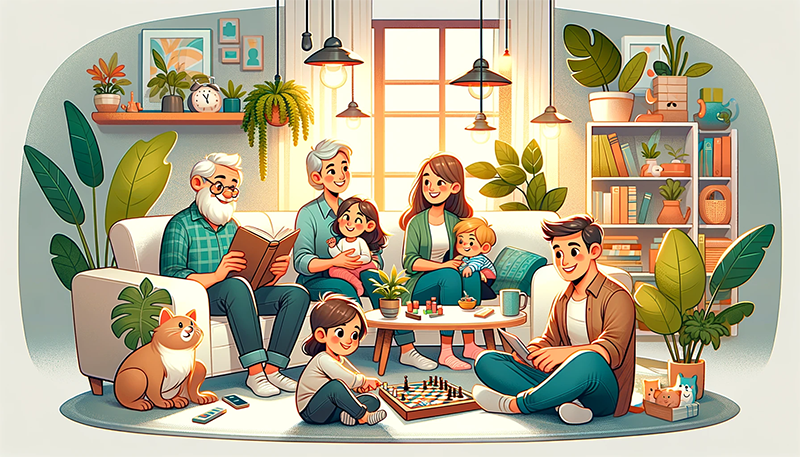As the old adage goes, "A happy family is but an earlier heaven." Creating a loving and supportive environment within your family is crucial for the well-being and development of each member. In today’s fast-paced world, it’s easy to get caught up in individual pursuits and neglect the very people who matter most. However, prioritizing family happiness can have a lasting impact on your relationships, mental health, and overall quality of life. In this article, we’ll explore practical strategies to increase family happiness, leading to a more harmonious and loving home.

1. Open Communication: The Foundation of Family Happiness
Effective communication is the cornerstone of a happy family. Encourage open and honest dialogue within your household by creating a safe and non-judgmental space for everyone to express themselves. This means actively listening to each other, avoiding criticism, and validating individual feelings and opinions. Regular family meetings or "talk time" can help foster a sense of unity and understanding.
2. Quality Time: Spending Time Together
In today’s digital age, it’s easy to get caught up in individual pursuits, leading to a sense of disconnection within the family. Scheduling regular quality time can help bridge this gap. This can include activities like:
- Family game nights
- Outdoor outings or picnics
- Cooking dinner together
- Reading or watching movies as a family
- Planning vacations or weekend getaways
3. Gratitude and Positivity
Focusing on the good things in life can have a profound impact on family happiness. Practice gratitude by:
- Sharing three things you’re thankful for at dinner time
- Creating a family gratitude journal
- Celebrating milestones and achievements
- Fostering a growth mindset and acknowledging individual efforts
4. Family Traditions: Creating Lasting Memories
Establishing family traditions can provide a sense of security, comfort, and belonging. These can include:
- Weekly dinner traditions (e.g., Sunday roasts or Friday night takeout)
- Annual holiday rituals (e.g., decorating the tree or making Easter baskets)
- Special activities or outings (e.g., going to the beach or visiting a local farm)
- Creative projects or crafts (e.g., making photo albums or painting together)
5. Conflict Resolution: Dealing with Disagreements
Conflicts are an inevitable part of family life. Learning healthy conflict resolution strategies can help minimize tension and promote understanding. This includes:
- Staying calm and patient
- Active listening and empathy
- Identifying and addressing underlying issues
- Finding common ground and compromising
- Apologizing and forgiving when necessary
6. Support and Encouragement
Providing emotional support and encouragement can boost individual confidence and overall family happiness. This can be achieved by:
- Offering genuine praise and recognition
- Celebrating individual achievements and milestones
- Being present and involved in each other’s lives
- Providing a helping hand when needed
- Creating a sense of belonging and acceptance
7. Personalized Parenting: Understanding Individual Needs
Each family member has unique needs, interests, and personalities. Tailoring your parenting approach to each individual can help promote happiness and understanding. This includes:
- Understanding and acknowledging individual strengths and weaknesses
- Creating personalized routines and schedules
- Encouraging individual pursuits and hobbies
- Offering emotional support and validation
8. Self-Care: Prioritizing Parental Happiness
Last but not least, don’t forget the importance of parental self-care. Happy parents = happy family! Make time for activities that nourish your mind, body, and soul, such as:
- Exercise or yoga
- Hobbies or creative pursuits
- Socializing with friends or pursuing individual interests
- Relaxation techniques (e.g., meditation or reading)
Frequently Asked Questions:
Q: How can I encourage my family members to communicate openly?
A: Start by creating a safe and non-judgmental space for conversation. Make an effort to listen actively and avoid criticism.
Q: What if we have different interests and can’t find common activities to do together?
A: Expose each other to new activities and find common ground. You may be surprised by the unexpected connections you make!
Q: How can I balance individual pursuits with family time?
A: Schedule regular family time and prioritize individual activities during other times. Make sure to communicate and set boundaries.
Q: What if we’re dealing with a difficult or rebellious family member?
A: Approach the situation with empathy and understanding. Avoid confrontation and focus on finding common ground and promoting open communication.
Conclusion
In conclusion, increasing family happiness requires effort, patience, and dedication. By implementing these strategies, you can create a loving, supportive, and harmonious home environment. Remember, every family is unique, and what works for one may not work for another. Be flexible, open-minded, and willing to adapt to the changing needs of your family members.
By prioritizing family happiness, you’ll not only strengthen your relationships but also:
- Improve mental health and well-being
- Enhance individual confidence and self-esteem
- Create lasting memories and traditions
- Foster a sense of unity and belonging
So, start today and begin building a happier, healthier, and more loving family!
Closure
Thus, we hope this article has provided valuable insights into Boosting Family Happiness: Strategies for a Harmonious Home. We appreciate your attention to our article. See you in our next article!